|
|
Canku Ota |
|
|
(Many Paths) |
||
|
An Online Newsletter Celebrating Native America |
||
|
November 2, 2002 - Issue 73 |
||
|
|
||
|
The Squirrels Fool Coyote |
||
|
|
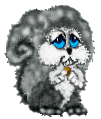 Not
many animals liked Coyote. Some thought he was foolish and others thought
he was boastful. The Squirrels didn't like him because he was mean to
them. Not
many animals liked Coyote. Some thought he was foolish and others thought
he was boastful. The Squirrels didn't like him because he was mean to
them.
One day when he was out walking, Coyote saw the Squirrels making lots of noise and rushing around under a tree. "Quick! Quick! Throw that rope over the
branch!" cried one. "I need a bag! I need a bag now!"
cried another. "What are you stupid Squirrels up to now?" asked Coyote. "We haven't got time to stop and talk Mr Coyote," squeaked one mouse, throwing a rope over another branch. "Haven't you heard? North Wind is on his way. He's going to throw hailstones as big as a bear's paw at all the animals! We're going to climb into these bags and pull ourselves up under the branches, so the hailstones can't hit us."
"Alright. You can join us," squeaked the Squirrels. "But you'll have to get your own bag and rope because we don't have anything big enough or strong enough to hold you." "No problem," said Coyote. "I've got everything I need at home". "Then hurry Mr Coyote, because North Wind will be here any minute." Coyote rushed off home. The Squirrels waited until he was out of sight, then fell over squeaking with laughter. When they saw him coming back they picked themselves up and pretended to tie more bags.
The Squirrels shook their heads doubtfully. Coyote yelled "do it, or I'll be mean to you!" "Alright," said the Squirrels. Coyote got into the bag and the Squirrels tied the rope around the top of it. A Squirrel picked up a small stone and threw it at the bag. "Ouch," said Coyote "I felt a hailstone already. Quick, get me up under the tree!" The Squirrels pulled on the rope until Coyote swung off the ground. Then they tied the end of the rope around the tree trunk.
When Coyote's bag was on the ground and the rope untied, Coyote slowly crawled out onto the ground, all battered and bruised. "I thought I was going to die," he said. "They must have been the biggest hailstones ever!"
"We tricked you, you dumb old Coyote," yelled the Squirrels as they scurried off into their holes, laughing. "I'll get you for this," howled Coyote, feeling his sore head. "But not today". "Ooow, my sore head. Ooow, my sore back. Ooow, my sore nose" he cried as he slowly hobbled home to bed. Print and Color Your Own Gray Squirrel |
|
|
|
Gray Squirrel (Sciurus
carolinensis)
|
|||||||
|
Description: Gray squirrels can be distinguished from other members of the squirrel family by: 1) soft, dense fur, uniformly colored, gray above and white below, 2) tail hairs buffy at the base, black in the middle and tipped with white, 3) yellowish brown head and sides, 4) white eye rings, and 5) rather prominent ears, tapering toward the tips. Seasonal differences in color are due to an annual molt in summer, and to fading. There is no difference in the colors of the sexes. Young are paler and more grayish than adults. They have a long, graceful and bushy tail (which is used for balance, as a parachute, or to protect the animal from the sun or cold). Size: Adults may attain the following dimensions: total length 380-525 mm; tail 150-250 mm; hind foot 54-76 mm; ear 28-35 mm; weight 300-713 grams. Reproduction: There are two peaks of reproduction per year, one in January, and a second in late May and early June. Females generally do not breed their first year. Males are promiscuous breeders and during the breeding period there is considerable activity. Several males may pursue a female in breeding condition up and down branches and from one tree to the next in what is termed a "mating chase." After a gestation period of approximately 44 days, one to eight (usually two to four) naked, pink young are born. The head and feet of the young are proportionately larger than the rest of the body. At birth the eyes and ears are closed. The ears open 28 days later and the eyes 4 days after that. In six weeks the body is covered with hair. In two months the young are weaned and are one-half grown. They are fully furred, and their tails are bushy. Young born in the spring disperse before the summer breeding period while those born in summer may disperse, or remain with the female through the winter. Females have eight nipples.
Gray squirrel nests typically are lined with plant fibers, and are placed either in a tree-hole or in a ball of dry leaves lodged among upper tree limbs, either type being suitable for summer or winter use. Although gray squirrels and fox squirrels are sometimes found in the same trees, they are compatible, and aggressive behavior between these species is rarely seen.
Remarks: Predators of gray squirrels include coyotes, foxes, bobcats, hawks, owls, and occasionally weasels, raccoons, and snakes. In summer, some gray squirrels show signs of mange (loss of hair from mite infection). Longevity for this squirrel is normally less than five years. Maximum wild longevity is 12.5 years (females) and 9 years (males). In captivity, one female lived more than 20 years.
"They crossed the Mississippi at that point, and worked their way down the river, until on Wednesday they reached Cape Girardue, crossing the river at that point in countless myriads. The citizens turned out en masse and killed them by the hundreds. -- Every tree and bush in that vicinity swarmed with them until night when they all disappeared, and have not been heard from since. Their route was marked as by a devastating storm. Trees were girdled, and fields destroyed. Old French settlers predict a very severe winter, as it was noticed in 1834 and '52 that immense droves of squirrels suddenly made their appearance, followed by intensely severe weather. -- St. Louis Express." Cool Facts:
|
|||||||
|
|
||
|
|
||
| Canku Ota is a free Newsletter celebrating Native America, its traditions and accomplishments . We do not provide subscriber or visitor names to anyone. Some articles presented in Canku Ota may contain copyright material. We have received appropriate permissions for republishing any articles. Material appearing here is distributed without profit or monetary gain to those who have expressed an interest. This is in accordance with Title 17 U.S.C. section 107. | ||
|
Canku Ota is a copyright © 2000, 2001, 2002 of Vicki Lockard and Paul Barry. |
||
 |
 |
|
|
The "Canku Ota - A Newsletter Celebrating Native America" web site and its design is the |
||
|
Copyright © 1999, 2000, 2001, 2002 of Paul C. Barry. |
||
|
All Rights Reserved. |
||
 Fearing
the hailstones, Coyote said "I'll join you." All the Squirrels
stopped dead in their tracks. "Ohhh! I don't know about that,"
they squeaked. "If you don't let me, I'll be mean to you again,"
shouted Coyote.
Fearing
the hailstones, Coyote said "I'll join you." All the Squirrels
stopped dead in their tracks. "Ohhh! I don't know about that,"
they squeaked. "If you don't let me, I'll be mean to you again,"
shouted Coyote.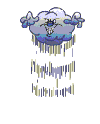 "You
must wait until last and pull yourself up, Mr Coyote, because you are
too heavy," said the Squirrels. "No. I'll go first,"
said Coyote. "North Wind is fast and could get here before I'm
protected. If all of you hold the end of the rope you can pull me up."
"You
must wait until last and pull yourself up, Mr Coyote, because you are
too heavy," said the Squirrels. "No. I'll go first,"
said Coyote. "North Wind is fast and could get here before I'm
protected. If all of you hold the end of the rope you can pull me up."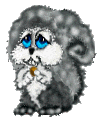 The
Squirrels picked up stones and threw them at the bag. "Ooowww!
Ooowww!" howled Coyote. "The hailstones hurt." "Be
brave Mr Coyote. The storm will pass soon," said the Squirrels.
And they picked up bigger stones to throw at the bag."Ooowww, my
head! Oooww, my back!" howled Coyote. Finally they stopped throwing
stones and one of the Squirrels said, "North Wind has gone now,
we can come down."
The
Squirrels picked up stones and threw them at the bag. "Ooowww!
Ooowww!" howled Coyote. "The hailstones hurt." "Be
brave Mr Coyote. The storm will pass soon," said the Squirrels.
And they picked up bigger stones to throw at the bag."Ooowww, my
head! Oooww, my back!" howled Coyote. Finally they stopped throwing
stones and one of the Squirrels said, "North Wind has gone now,
we can come down." Coyote
felt the ground. It was dry. He looked up at the blue sky and there
wasn't a cloud to be see. "How could this be? We've just had a
hailstorm," he said.
Coyote
felt the ground. It was dry. He looked up at the blue sky and there
wasn't a cloud to be see. "How could this be? We've just had a
hailstorm," he said.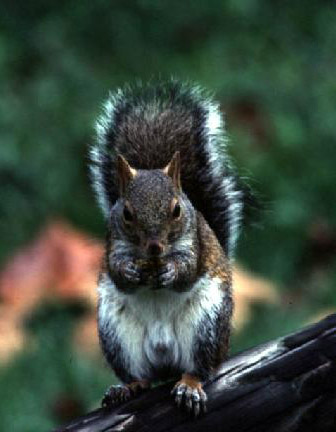 Eastern
gray squirrels are found throughout the eastern United States; their
natural range extends from Florida, north to Canada, and west to where
the deciduous forests meet the great plains grasslands. The genus name
Sciurus is from the Greek words skia (shadow) and oura (tail), a reference
to the bushy tail which casts a shadow on the squirrel. The Latinized
species name carolinensis (of Carolina) refers to the region from which
the first scientific specimen was collected.
Eastern
gray squirrels are found throughout the eastern United States; their
natural range extends from Florida, north to Canada, and west to where
the deciduous forests meet the great plains grasslands. The genus name
Sciurus is from the Greek words skia (shadow) and oura (tail), a reference
to the bushy tail which casts a shadow on the squirrel. The Latinized
species name carolinensis (of Carolina) refers to the region from which
the first scientific specimen was collected. Habits:
Gray squirrels are diurnal and usually active from early morning to
late evening in both summer and winter. When observed they are often
feeding on tree buds at the ends of branches with their bodies outstretched
to full extent and tail hanging straight down. At other times they may
rest on a horizontal limb with tail arched over the back as if screening
themselves from the sun or potential predators. Sometimes an animal
will assume this position partially supported by its legs, but frequently
will be lying upon its belly with legs dangling. The species is more
arboreal than terrestrial, is well adapted for climbing, and can negotiate
any angle or side of a tree or limb. Adults may jump as far as 2.5 meters
between trees. Gray squirrels are frequently observed crossing roads
or small creeks through the tree canopy. They are shy squirrels and
will attempt to place a tree trunk or limb between themselves and an
intruder. On the ground, this squirrel searches for food by hopping
or moving with an ambling walk. They typically feed while resting on
their hind quarters while adeptly manipulateing food with their front
feet. When disturbed they move with great speed either on the ground
or in trees. Upon reaching an elevated refuge they may call with a characteristic
scolding noise, the tail flipping with each bark. Home range size is
usually less than five hectares. Male home ranges are typically larger
than those of females.
Habits:
Gray squirrels are diurnal and usually active from early morning to
late evening in both summer and winter. When observed they are often
feeding on tree buds at the ends of branches with their bodies outstretched
to full extent and tail hanging straight down. At other times they may
rest on a horizontal limb with tail arched over the back as if screening
themselves from the sun or potential predators. Sometimes an animal
will assume this position partially supported by its legs, but frequently
will be lying upon its belly with legs dangling. The species is more
arboreal than terrestrial, is well adapted for climbing, and can negotiate
any angle or side of a tree or limb. Adults may jump as far as 2.5 meters
between trees. Gray squirrels are frequently observed crossing roads
or small creeks through the tree canopy. They are shy squirrels and
will attempt to place a tree trunk or limb between themselves and an
intruder. On the ground, this squirrel searches for food by hopping
or moving with an ambling walk. They typically feed while resting on
their hind quarters while adeptly manipulateing food with their front
feet. When disturbed they move with great speed either on the ground
or in trees. Upon reaching an elevated refuge they may call with a characteristic
scolding noise, the tail flipping with each bark. Home range size is
usually less than five hectares. Male home ranges are typically larger
than those of females. 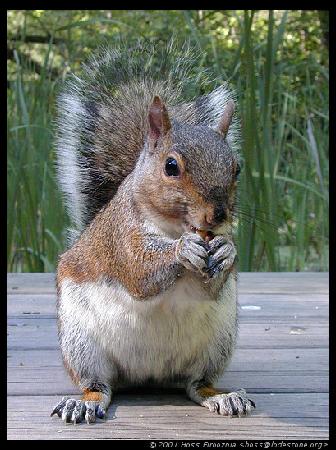 Food:
The food of gray squirrels is principally nuts, eaten according to the
cycle of nut reproduction which generally peaks in the autumn. Buried
nuts are relocated by a keen sense of smell and eaten at various times
during the winter. Unexcavated nuts are potential seedlings the following
season. Seeds, fruits, buds, leaves, flowers, and insects are eaten
also and, because of the gray squirrel's ability to travel through trees,
it occasionally eats bird eggs and nestlings. Winter survival of squirrels
is greatly affected by the size of the Fall mast.
Food:
The food of gray squirrels is principally nuts, eaten according to the
cycle of nut reproduction which generally peaks in the autumn. Buried
nuts are relocated by a keen sense of smell and eaten at various times
during the winter. Unexcavated nuts are potential seedlings the following
season. Seeds, fruits, buds, leaves, flowers, and insects are eaten
also and, because of the gray squirrel's ability to travel through trees,
it occasionally eats bird eggs and nestlings. Winter survival of squirrels
is greatly affected by the size of the Fall mast.